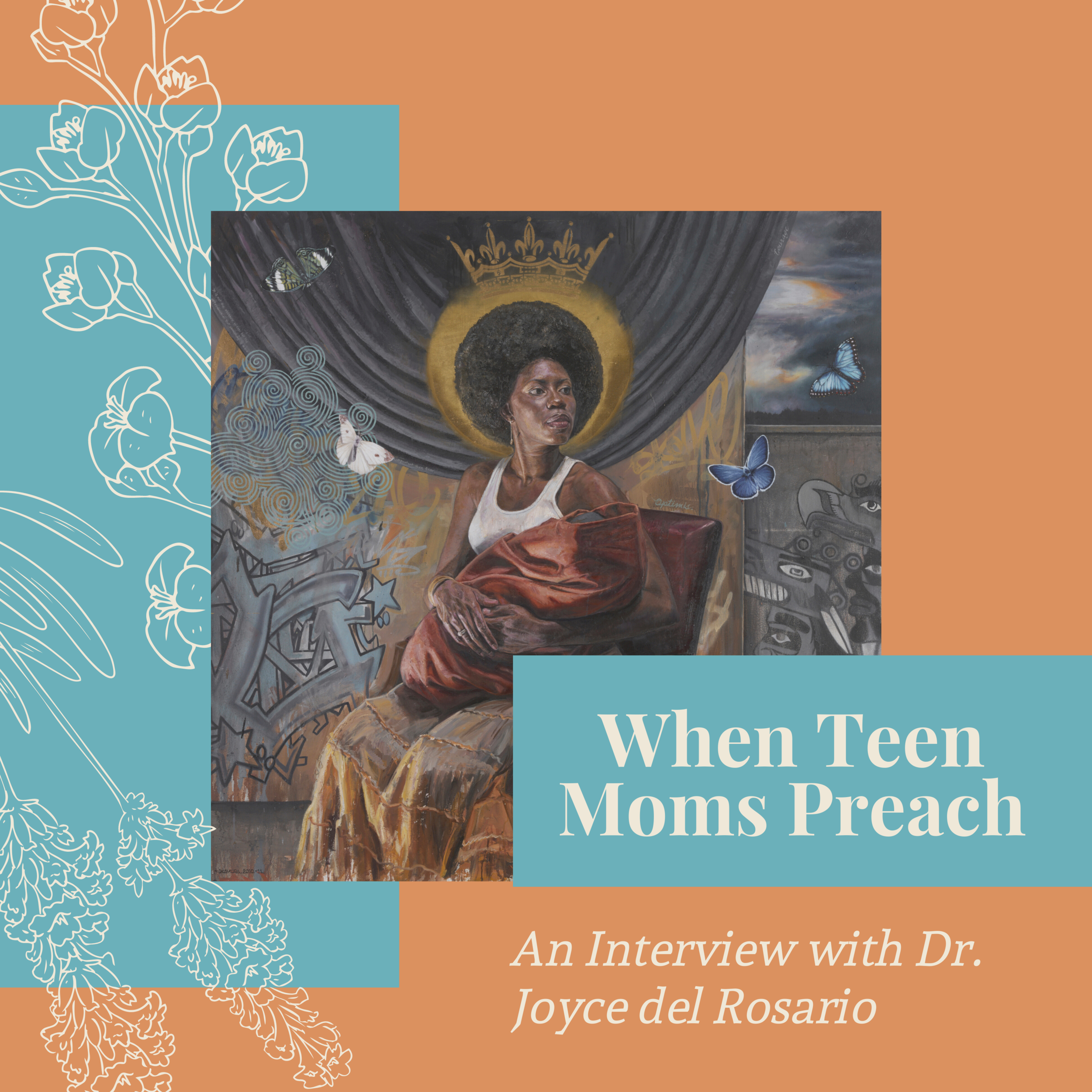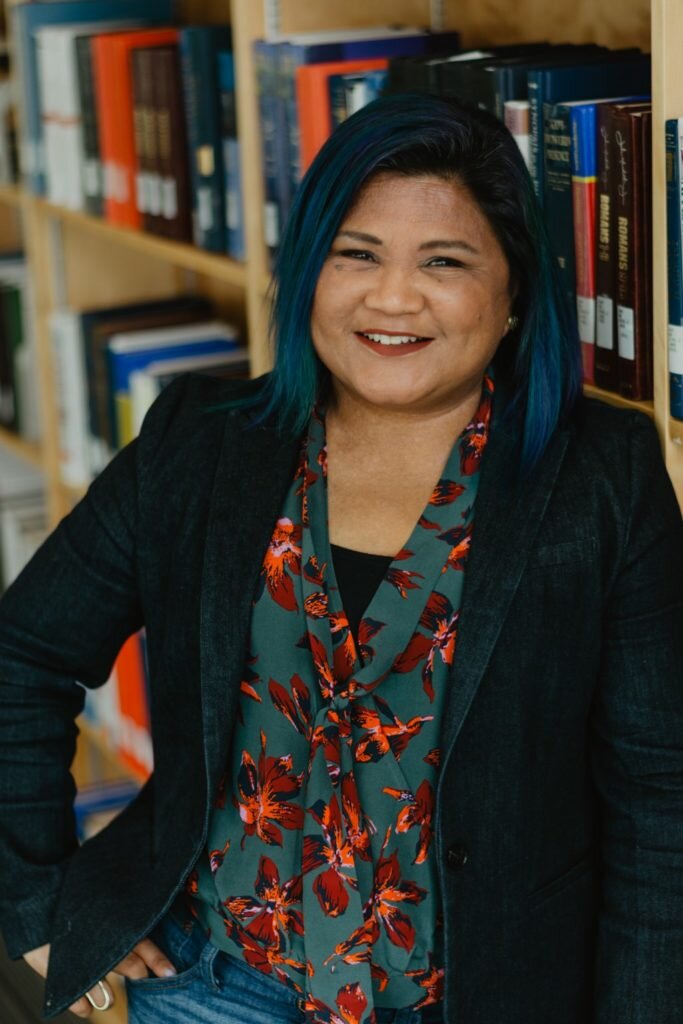Dr. Joyce del Rosario reintroduces us to a biblical Mary, through the eyes of unsuspecting theologians and the unfamiliar likenesses of an icon. Meet a Mary who is unseen and forgotten by many, yet intimately known among those who share her experience. Dr. del Rosario, labors to center the margins, through Mary, the Teen Mother of God, taught to us by the teen mothers of our cities.
“Greetings, you who are highly favored!
The Lord is with you.”
-Luke 1:28-”
God meets us in the most unlikely of places. For Dr. Joyce del Rosario, it was in a doctoral seminar class. Her class was in the middle of examining the Vatican II documents, which were written in 1966 by the Catholic church to re-establish key doctrines. One of the doctrines in question was the role of Mary within the church. There, among her aspiring Evangelical PhD colleagues, which was noticeably predominantly male, she found an underwhelming amount of interest in the Mother of God. So, with only a swift overview, her class found it fitting to move on. Del Rosario, however, did not share this sentiment. Stuck on this woman, she found the subject of her dissertation. Resolved, del Rosario, dedicated her next few years to the study of Mary, the Teen Mother of God.
This is the story Dr. del Rosario shared with me in our recent interview together. She was quick to explain that this moment of academic discovery didn’t happen in a vacuum. Prior to pursuing her PhD at Fuller Theological Seminary, del Rosario served over 20 years in Urban Youth Ministry at New Creation Home in Palo Alto, CA. She specialized in ministry specifically to marginalized teen mothers, predominantly Latina and African American. It was in these black and brown faces that she found a likeness to the woman she read about in Luke 1.
Mary was a teen mom. And a marginalized teen mom at that. In fact, del Rosario was quick to remind me of the fact that God’s very choice of the single teen Mary was a divine critique on the human conventions of economics, social class, and gender—just to name a few. In an article for Relevant magazine, she writes:
Although she is self identified as a “servant-girl,” although she is economically and socially vulnerable as a young, single girl with no one to fully claim ownership of her until her marriage is solidified, although she has no status or title to speak of, God, through the angel Gabriel, calls her “highly favored.”[1]
Nothing was simple about the call of God on young Mary. The complexity of societal scandal, family disownment, and potential rejection from her suitor all weighed heavily on the sore shoulders of this vulnerable teen.
“Mary was greatly troubled at his words and
wondered what kind of greeting this might be.”
-Luke 1:29-”
Mary’s marginalized and vulnerable status is often neglected in our retelling of her story. Dr. del Rosario sensed this by the disinterested silence of her seminary colleagues in Mary, the Mother of God. Nevertheless, she knew that God had something important to give to the church through this teen mom. More so, she believed that it was the marginalized and the vulnerable who would have insight into exactly what that was. What she would soon realize, through her research, is that no one could understand Mary more profoundly than the young, unseen mothers of our cities.
Dr. del Rosario went on to explain just how astounded she was by these young mothers’ insight into the personhood of Mary. “I learned,” she confessed, “what profound theologians teen moms can be.” Unfortunately, communicating these theologians’ thoughts proved to be a challenge.
Just like in Mary’s time, we find an unbalance in the systems that man builds. There is a hierarchy and a belief that there are people who have something to say—usually educated, usually white—and the rest are meant only to listen and to take in with thanksgiving. Dr. del Rosario’s work directly challenges this system. In her experience, she found that the teen mothers she worked with had much to say to the church, if only the church would listen.
This was del Rosario’s challenge. She needed a medium, a bridge to carry the message of these unseen theologians.
Then. She found Tim Okomara’s Courage 3.0. [2]
Courage 3.0 is a painting emulating the traditional iconography of Mary. The classic elements are present. The subject is a young woman holding a baby. Her eyes register a resolute purpose of being. She is a mother, yet she is the sole adult in the image, and she looks strong. Around her head is a bright brimming halo with a crown to make even clearer her stately status. However, there is something decidedly different about this image of Mary. At first glance you might reject a likeness of the mother in this painting to the Mary we have grown accustom to. This is because Okomara’s Mary is a dark colored girl, donning an afro and surrounded by graffiti. “It was the most beautiful picture of Mary I had ever seen,” del Rosario explained, “she looked like the teen moms I knew.” This Mary looked both fierce and restless, courageous and vulnerable. She was a Mary with whom del Rosario was familiar.
“Icons,” Joyce reminds us, “transcend our human constructs like race and class.” It became clear, that this was her bridge. Contemporary icons that emulated this marginalized, Jewish teen mother would give her teen theologians the passage to preach. She would use icons to help bridge the chasm of biblical literacy. Historically, when the majority of people were illiterate, the masses looked to art and icons to connect to God. For centuries, the faces of icons stained in glass and lit by light was where God met the poor, marginalized and uneducated. Icons in stained glass windows was how God spoke for generations; they were the filter between the earth and the sky.
Icons, then, were what del Rosario would use to bridge the gap of the marginalized and the educated. Through them she found she could democratize religious power, by giving those who are often passed by in the church, the marginalized teen mother, the pulpit to speak. By making this the content of her dissertation, Rosario would bring to light both in the academy and whatever pulpit she was offered, the message of these young teen moms. Thus, for her dissertation research, del Rosario curated a collection of contemporary images of Mary and selected her focus groups: Teen mothers and the Women who mentor them.
What she found humbled her. While the Mentors were immediately aware of the iconology of Mary emulated through the images, the Teen Mothers were unaware of this fact. This, del Rosario explained, created very different insights. The Mentors, conditioned by an image of a Virgin Mary produced an almost recycled list of insights on the Mary they felt familiar with, even though the Mary shown to them was radically and racially different. The Teen Mothers, on the other hand, unconditioned and free from a conventional list of “right” ways to see Mary, described a woman who was like them: human, stuck in a hard position, ready to fight to the death for the baby she held, tired, alone, and resolved to rise to the position in which she found herself. This was the Mary that the Teen Mothers of questionable circumstances and racialized realities preached. Arguably, this is the Mary whom the church must refamiliarize herself with, because it is only then that we can see her Son for who he truly is: the brown, poor, and marginalized Son of God, born of a teen mom.
In her final comments, Rosario labored to communicate that we should stop assuming that we as evangelicals “bring Jesus to the margins”. “Jesus,” she expressed, “already exists in the margins!” He was, after all born there. She concluded our interview asserting that it is not about “giving the margins Jesus”, but rather, “it is about seeing the Jesus the margins already know.”
The work that Dr. Joyce del Rosario dedicated her academic life to is work that we should all strive to incorporate in our churches. It is the work of centering the margins—of allowing a teen mother to preach.
“ And Mary said:
“My soul glorifies the Lord and my spirit rejoices in God my Savior, for he has been mindful of the humble state of his servant.”
-Luke 1:46-48-”
More about Joyce del Rosario:
From her bio found here
Dr. del Rosario earned her M.Div. from Princeton Theological Seminary and her PhD from Fuller Theological Seminary School of Intercultural Studies. Her research interests include youth ministry with a special focus on teen moms and urban and multiethnic youth ministry, social justice and racial reconciliation, theological anthropology, marginalized women, and postcolonial Filipino-American theology.
She is on the Board of the Directors for the Christian Community Development Association, where she is committed to encouraging and equipping churches and organizations across the country to transform their neighborhoods through community development. Dr. del Rosario is also on Fuller Youth Institute’s Expert Advisory Council for the Character and Virtue Development in Youth Ministry (CVDYM) planning project, funded by the John Templeton Foundation.
About Jelyn Leyva
A Second-generation Filipina born in Tampa, FL, Jelyn Leyva graduated Moody Bible Institute in Chicago on May 2017 with a Bachelor’s degree in Women in Ministry and an Interdisciplinary in Theology. She is currently in Los Angeles, CA pursuing an MDiv at Fuller Theological Seminary with her emphasis in Christian Ethics. Having lived in various places in the US, Jelyn’s interest lie in the complex history and multi-ethnic life of the Protestant Church in the US. Her hope is to serve this church and its many colors with the consideration of traditional and contemporary theological scholarship.
Footnotes
[1] “Dear Politicians, Leave Mary Out of the Sex Abuse Scandal,” RELEVANT Magazine (blog), November 13, 2017, https://relevantmagazine.com/current/dear-politicians-leave-mary-out-of-this/.
[2] Tim Okamura, “Courage 3.0, 2010-2012”




